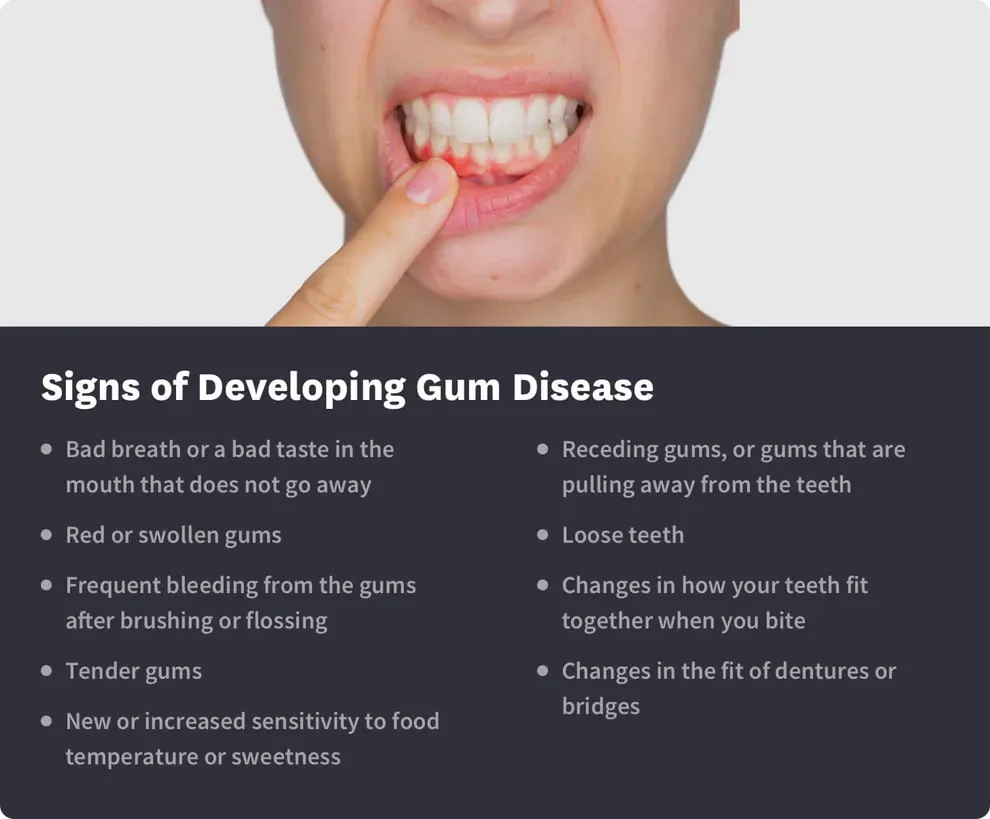Dip Gum Disease: Treatment Options & Future Prevention

Table of Contents
- What Is Dip Gum Disease?
- Causes & Signs
- Preventing Dip Gum Disease From Getting Worse
- Frequently Asked Questions
- References
Dip gum disease develops due to use of dip, which is a type of smokeless tobacco that is chewed.
Most people are well aware of the risks of smoking cigarettes or cigars, but many mistakenly believe that other tobacco products are safer and less addictive. Chewing tobacco products like dip actually increase the risk of periodontal disease, or gum disease.
What Is Dip Gum Disease?
Tobacco is one of the most addictive substances in the world. Although many people are aware of the dangers associated with smoking, other types of tobacco use are also harmful. This includes smokeless tobacco products like snuff, chewing tobacco, or dip.
Dip is a type of processed leaf tobacco that is placed in the mouth and, often, chewed. Chemicals in these plugs are absorbed through the gums and throat.
While dip is not swallowed, it is still associated with high rates of oral diseases, including gum disease and oral cancer. Dip gum disease might start as discoloration in the teeth, but it quickly progresses to other problems that can lead to tooth loss and even jaw infection.
Causes & Signs of Dip Gum Disease
There are more than 4,000 different chemicals in dip, about 30 of which are directly linked to oral cancer. However, these chemicals can also cause other problems with oral hygiene, particularly dip gum disease, a type of periodontitis known to come from using dip tobacco.
The term periodontal disease refers to gum disease, which often begins as gingivitis, a mild type of gum disease. Most American adults have had gingivitis, but regular visits to your dentist for cleanings and checkups can stop it in its tracks.
According to the Centers for Disease Control and Prevention (CDC), around 47 percent of adults in the US, ages 30 and older, have had some type of gum disease. The risk of periodontal disease increases with age, with over 70 percent of US adults who are 65 or older having some form of periodontal disease.
Dip use increases the risk of periodontal disease appearing at a younger age and getting worse faster.

These are signs of developing gum disease:
Bad breath or a bad taste in the mouth that does not go away
Red or swollen gums
Frequent bleeding from the gums after brushing or flossing
Tender gums
New or increased sensitivity to food temperature or sweetness
Loose teeth
Receding gums, or gums that are pulling away from the teeth
Changes in how your teeth fit together when you bite
Changes in the fit of dentures or bridges
Many people brush off early signs of gum disease, like bleeding or bad breath. However, one of the most noticeable signs of periodontal disease is gum recession. If your teeth appear longer than before, especially if your teeth begin to feel loose or shift out of place, you may have periodontal disease.
If you use dip tobacco, this issue might be accompanied by discoloration of the teeth. Gum recession exposes the roots of your teeth, which increases the risk of infection and worsening oral health.
Preventing Dip Gum Disease From Getting Worse
There is no safe way to use tobacco, including dip or similar products. If you use dip, snuff, or other types of orally consumed tobacco, the best way to prevent dip gum disease, or stop it from getting worse, is to quit using tobacco.
You can get help from your dentist or regular doctor to quit tobacco use. In some cases, you can even get prescriptions for medications that can help you quit.
There are other steps you can take at home to slow down the progression of dip gum disease:
Brush and floss your teeth regularly, with a soft-bristled brush. You may consider getting special toothpaste or mouthwash for sensitive teeth to reduce any pain in your gums.
Adjust your diet to reduce consumption of sugary and acidic foods and drinks, including soda, candy, white bread, and even fruit juice.
Take all medications as prescribed, including antibiotics that stop infection in your gums. If you have underlying health conditions like diabetes, let your dentist know so they can monitor your oral health.
Regular visits to your dentist for checkups and cleanings mean any gum disease will be diagnosed quickly, but if you notice signs of periodontal disease between visits, contact your dentist and ask for an immediate appointment.
If you struggle with tobacco addiction, including to dip, you can decrease the likelihood of dip gum disease by quitting.
Frequently Asked Questions
No. Dip gum disease is a periodontal disease that caused by dipping tobacco. The disease causes damage to the soft tissues and bones that anchor your teeth, the periodontium. Unchecked periodontium inflammation can lead to teeth loosening and receding gums.
Gingivitis is the inflammation of the gums. It is a relatively common early-stage reversible gum condition characterized by swollen or bleeding gums.
There is no cure for dip gum disease (periodontal disease) once it progresses to periodontitis. At this stage, you can only treat and manage the disease through antibiotics, root planning scaling and several types of surgery. You can reverse gum disease if it is diagnosed while it's still in an early stage.
